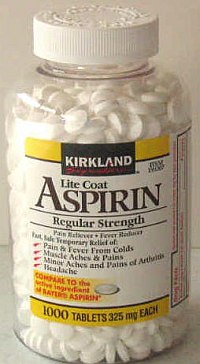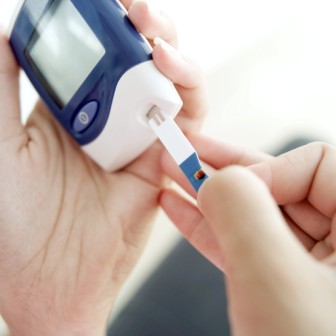My wife has been taking high dosages of aspirin two or three times a day for the last few months as she had some clots show up on her legs and the doctor, after having me give her injections to thin her blood, gave her this prescrition for a generic type of aspirin derivative that she is taking. As always I scoured the internet to find more information on taking aspirin and I have copied the following info from both Wikipedia and the FDA in case you have a simeilar interest. The wiki info is an outline on aspirin itself and the FDA info is a bunch of questions and answers about aspirin.
Aspirin or acetylsalicylic acid (acetosal) is a drug in the family of salicylates, often used as an analgesic (against minor pains and aches), antipyretic (against fever), and anti-inflammatory. It has also an anticoagulant (“blood-thinning”) effect and is used in long-term low-doses to prevent heart attacks.
Advantages of Low Dose Aspirin Usage
Low-dose long-term aspirin irreversibly blocks the formation of thromboxane A2 in platelets, producing an inhibitory effect on platelet aggregation, and this blood-thinning property makes it useful for reducing the incidence of heart attacks. Aspirin produced for this purpose often comes in 75 or 81 mg dispersible tablets and is sometimes called “Junior aspirin”. High doses of aspirin are also given immediately after an acute heart attack. These doses may also inhibit the synthesis of prothrombin and may therefore produce a second and different anticoagulant effect.
Several hundred fatal overdoses of aspirin occur annually, but the vast majority of its uses are beneficial. Its primary undesirable side effects, especially in stronger doses, are gastrointestinal distress (including ulcers and stomach bleeding) and tinnitus. Another side effect, due to its anticoagulant properties, is increased bleeding in menstruating women. Because there appears to be a connection between aspirin and Reye’s syndrome, aspirin is no longer used to control flu-like symptoms in minors.
Aspirin – The First NSAID

Aspirin was the first discovered member of the class of drugs known as non-steroidal anti-inflammatory drugs (NSAIDs), not all of which are salicylates, though they all have similar effects and a similar action mechanism.
Hippocrates, a Greek physician, wrote in the 5th century BC about a bitter powder extracted from willow bark that could ease aches and pains and reduce fevers. This remedy is also mentioned in texts from ancient Sumeria, Egypt and Assyria. Native Americans claim to have used it for headaches, fever, sore muscles, rheumatism, and chills. The Reverend Edward Stone, a vicar from Chipping Norton, Oxfordshire England, noted in 1763 that the bark of the willow was effective in reducing a fever.
Aspirin Isolated from Willow Bark and Flowers
The active extract of the bark, called salicin, after the Latin name for the White willow (Salix alba), was isolated to its crystalline form in 1828 by Henri Leroux, a French pharmacist, and Raffaele Piria, an Italian chemist. Piria was able to convert the substance into a sugar and a second component, which on oxidation becomes salicylic acid.
This chemical was also isolated from meadowsweet flowers (genus Filipendula, formerly classified in Spiraea) by German researchers in 1839. While their extract was somewhat effective, it also caused digestive problems such as irritated stomach and diarrhea, and even death when consumed in high doses. In 1853, a French chemist named Charles Frederic Gerhardt neutralized salicylic acid by buffering it with sodium (sodium salicylate) and acetyl chloride, creating acetosalicylic anhydride. Gerhardt’s product worked, but he had no desire to market it and abandoned his discovery. In 1897, researcher Arthur Eichengrun and Felix Hoffmann, a research assistant at Friedrich Bayer & Co. in Germany, derivatized one of the hydroxyl functional groups in salicylic acid with an acetyl group (forming the acetyl ester), which greatly reduced the negative effects. This was the first synthetic drug, not a copy of something that existed in nature, and the start of the pharmaceuticals industry.
Several claims to invention of acetylsalicylic acid have arisen. Acetylsalicylic acid was already being manufactured by the Chemische Fabrik von Heyden Company in 1897, although without a brand name. Arthur Eichengrün claimed in 1949 that he planned and directed the synthesis of aspirin while Hoffmann’s role was restricted to the initial lab synthesis using Eichengrün’s process. In 1999, Walter Sneader of the Department of Pharmaceutical Sciences at the University of Strathclyde in Glasgow reexamined the case and agreed with Eichengrün’s account. Bayer continues to recognize Felix Hoffmann as aspirin’s official inventor. Despite its argued origin, Bayer’s marketing was responsible for bringing it to the world.
More recent work has shown that there are at least two different types of cyclooxygenase: COX-1 and COX-2. Aspirin inhibits both of them. Newer NSAID drugs called COX-2 selective inhibitors have been developed that inhibit only COX-2, with the hope for reduction of gastrointestinal side-effects.
Dangers of Cox-2 Inhibitors and Heart Attacks
However, several of the new COX-2 selective inhibitors have been recently withdrawn, after evidence emerged that COX-2 inhibitors increase the risk of heart attack. It is proposed that endothelial cells lining the arteries in the body express COX-2, and, by selectively inhibiting COX-2, prostaglandins (specifically PGF2) are downregulated with respect to thromboxane levels, as COX-1 in platelets is unaffected. Thus, the protective anti-coagulative effect of PGF2 is decreased, increasing the risk of thrombus and associated heart attacks and other circulatory problems. Since platelets have no DNA, they are unable to synthesize new COX once aspirin has irreversibly inhibited the enzyme, rendering them “useless”: an important difference with reversible inhibitors.
Furthermore, aspirin has 2 additional modes of actions, contributing to its strong analgesic, antipyretic and antiinflammatory properties:
It uncouples oxidative phosphorylation in cartilaginous (and hepatic) mitochondria.
It induces the formation of NO-radicals in the body that enable the white blood cells (leukocytes) to fight infections more effectively. This has been found recently by Dr. Derek W. Gilroy, winning Bayer’s International Aspirin Award 2005.
Questions about Aspirin
Q. What are the different uses for aspirin?
Strokes: A neurosurgeon will often explain how aspirin use is recommended in both men and women to treat mini-strokes (transient ischemic attack –TIA) or ischemic stroke to prevent subsequent cardiovascular events or death.
Heart Attacks:
- reduces the risk of death in patients with suspected acute heart attacks (myocardial infarctions)
- prevents recurrent heart attacks and
- reduces the risk of heart attacks or sudden death in patients with unstable and chronic stable angina pectoris (chest pain).
- Other coronary conditions: Aspirin can be used to treat patients who have had certain revascularization procedures such as angioplasty, and coronary bypass operations — if they have a vascular condition for which aspirin is already indicated.
Rheumatologic diseases: Aspirin is indicated for relief of the signs and symptoms of rheumatoid arthritis, juvenile rheumatoid arthritis, osteoarthritis, spondylarthropathies, and arthritis and pleurisy associated with systemic lupus erythematosus.
Pain relief: Aspirin is indicated for the temporary relief of minor aches and pains.

Q. What does this mean for doctors and medical practice?
A. Doctors and health care professionals will be provided with full prescribing information about the use of aspirin in both men and women who have had a heart attack, stroke, certain other cardiovascular conditions and rheumatologic diseases. For stroke and cardiovascular conditions, lower doses are recommended than those previously prescribed by physicians in practice. Information on the use of aspirin for rheumatologic diseases has also been expanded to include specific dosing information as well as information about side effects and toxicity. Thus, doctors will have full prescribing information on aspirin and the assurance that aspirin is a safe and effective treatment for heart attacks, strokes, certain other vascular conditions and rheumatologic diseases.
Q. What is the basis for the prescribing information?
A. The information on the uses of aspirin is based on scientific studies that support treatment with aspirin for heart attacks, strokes, and some related conditions. Convincing data support these uses in lower doses than previously believed to be effective in treating heart attacks and strokes in both men and women.
Q. What does this mean for patients?
A. Physicians will be better able to prescribe the proper doses for these uses for male and female patients with these medical conditions. Dose-related adverse events for patients with stroke and cardiovascular conditions should be minimized because lower dosages are recommended. The full prescribing information now provided for physicians who treat rheumatologic diseases will enhance the safe and effective prescribing of aspirin to these patients as well.
Q. Is FDA concerned that some patients may self-treat?
A. FDA emphasizes that consumers should not self-medicate for these serious conditions because it is very important to make sure that aspirin is their best treatment. In these conditions, the risk and benefit of each available treatment for each patient must be carefully weighed. Patients with these conditions should be under the care and supervision of a doctor.
Q. If a consumer is interested in using aspirin to prevent or treat symptoms of heart problems, what should he or she do?
A. Consumers should always first ask their doctor. In fact, aspirin products are labeled this way: “Important: See your doctor before taking this product for other new uses of aspirin because serious side effects could occur with self treatment.”
Q. Do the data on treatment or prevention of cardiovascular effects pertain only to aspirin?
A. Yes. Although acetaminophen, ibuprofen, naproxyn sodium and ketoprofen are good drugs for pain and fever, as is aspirin, only aspirin has demonstrated a beneficial effect for heart attack and stroke.
Q. What should consumers be made aware of?
A. Consumers should be informed that these professional uses of aspirin may be lifesaving when used upon the recommendation and under the supervision of a doctor. However, they must also be informed that even familiar and readily available products like aspirin may have important risks when used in new ways. For example, because aspirin can cause bleeding; in rare cases bleeding in the brain may occur in people who are using aspirin to prevent stroke. Therefore these uses should be recommended and monitored by a physician.
Q. What should consumers do if they are taking other pain medications such as ibuprofen?
A. Consumers who have been told by their doctor to take aspirin to help prevent a heart attack, should know that taking ibuprofen at the same time, for pain relief, may interfere with the benefits of aspirin for the heart. It is alright to use them together, but the FDA recommends that consumers contact their doctor for more information on the timing of when to take these two medicines, so that both medicines can be effective.
Q. What should consumers who are taking low dose aspirin for disease maintenance or prevention know about alcohol use?
A. Patients who consume 3 or more alcoholic drinks every day should be counseled about the bleeding risks involved with chronic, heavy alcohol use while taking aspirin.
Q. Can consumers safely use aspirin to treat suspected acute heart attacks?
A. If consumers suspect they are having a heart attack, their most important action must be to seek emergency medical care immediately. The advise and supervision of a doctor should direct this use of aspirin and patients are encouraged to speak with their doctor about this use.
Aspirin or acetylsalicylic acid (acetosal) is a drug in the family of salicylates, often used as an analgesic (against minor pains and aches), antipyretic (against fever), and anti-inflammatory. It has also an anticoagulant (“blood-thinning”) effect and is used in long-term low-doses to prevent heart attacks.
Low-dose long-term aspirin irreversibly blocks the formation of thromboxane A2 in platelets, producing an inhibitory effect on platelet aggregation, and this blood-thinning property makes it useful for reducing the incidence of heart attacks. Aspirin produced for this purpose often comes in 75 or 81 mg dispersible tablets and is sometimes called “Junior aspirin”. High doses of aspirin are also given immediately after an acute heart attack. These doses may also inhibit the synthesis of prothrombin and may therefore produce a second and different anticoagulant effect.
Several hundred fatal overdoses of aspirin occur annually, but the vast majority of its uses are beneficial. Its primary undesirable side effects, especially in stronger doses, are gastrointestinal distress (including ulcers and stomach bleeding) and tinnitus. Another side effect, due to its anticoagulant properties, is increased bleeding in menstruating women. Because there appears to be a connection between aspirin and Reye’s syndrome, aspirin is no longer used to control flu-like symptoms in minors.[1]
Aspirin was the first discovered member of the class of drugs known as non-steroidal anti-inflammatory drugs (NSAIDs), not all of which are salicylates, though they all have similar effects and a similar action mechanism.
Q. What do we know about how aspirin works for heart conditions and stroke?
A. The mechanism by which aspirin works in the treatment of heart attack and stroke is not completely understood. However, as an antiplatelet drug, we do know that aspirin help reduce platelet clumping which helps cause blockage in blood vessels.
Q. Who should NOT take aspirin?
A. Generally, people who have:
- allergy to aspirin or other salicylates
- asthma
- uncontrolled high blood pressure
- severe liver or kidney disease
- bleeding disorders
Always check first with your doctor to determine whether the benefit of these professional uses of aspirin is greater than the risks to you.
Q. What other side effects are associated with aspirin?
A. There is a wide range of adverse reactions that may result from aspirin use including effects on the body as a whole, or on specific body systems and functions.
High doses can cause hearing loss or tinnitus– ringing in the ears. (Note that this usually only occurs with large doses as prescribed in rheumatologic diseases and is rare in treatment with low doses used for cardiovascular purposes.)
Q. What is key message for Consumers?
A. The results of studies of people with a history of coronary artery disease and those in the immediate phases of a heart attack have proven to be of tremendous importance in the prevention and treatment of cardiovascular and cerebrovascular diseases.
Studies showed that aspirin substantially reduces the risk of death and/ or non-fatal heart attacks in patients with a previous MI or unstable angina pectoris which often occur before a heart attack. Patients with these conditions should be under the care and supervision of a doctor.
Aspirin has potential risks as well as benefits, like any drug. Patients should be careful to ask their doctor or health care professional before deciding whether aspirin is right for them and how much aspirin they should take.
Q. What were the major studies used to verify the effectiveness of aspirin for these indications?
A. Numerous studies both in the United States and abroad were evaluated to establish the safety and efficacy of aspirin for the cardiovascular and cerebrovascular indications and dosing information.
Major studies included:
- ISIS – 2 (Second International Study of Infarct Survival) (Ref 7)
- SALT (Swedish Aspirin Low-Dose Trial (Ref 22)
- ESPS-2 (European Stroke Prevention Study (Ref 23)
- UK-TIA (United Kingdom Transient Ischaemic Attack) Aspirin Trial (Ref 11)
- SAPAT (Stable Angina Pectoris Aspirin Trial) (Ref. 27)
- Canadian Cooperative Study Group (Ref. 8)
- W.S. Fields et al., Controlled Trial of Aspirin in Cerebral Ischemia (Ref 10)
* Note the reference numbers refer to the citations in the Final Rule.



